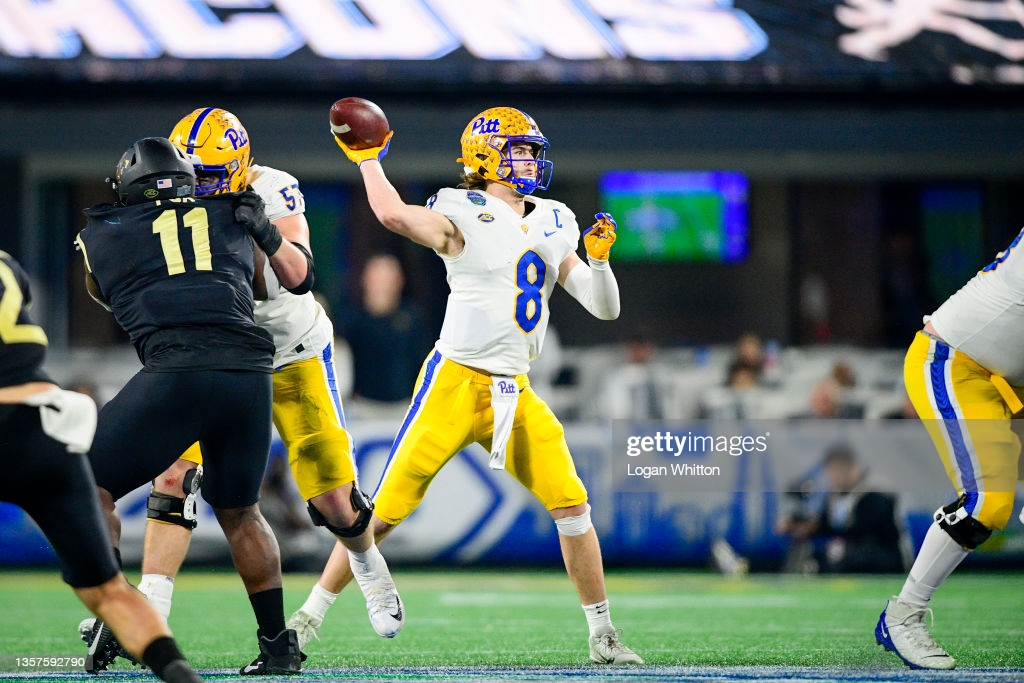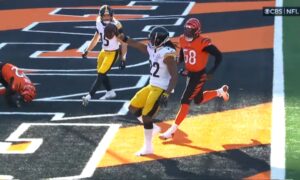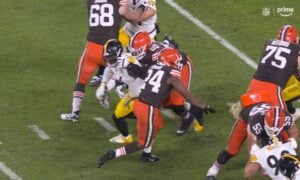I’d like to get ahead of my series on the different draft prospects in order to discuss a basic question of draft philosophy. The bottom line is that I do not think the Steelers should use a Round 1 pick on any of the 2022 QB prospects, though I’d like a Round 2 pick on most of them. Here is the situation as I see it:
PART I
- It is possible to win a Super Bowl with a placeholder QB instead of a franchise QB, but the margins of error are very tight, and the rest of the Pittsburgh offense won’t be up to that task without significant investments. That’s why (a) QB is the most important position on any team, and (b) the team cannot afford to throw away early draft picks on long shot bets.
- Ben Roethlisberger’s retirement leaves a hole at that most important position.
- The Steelers have three players on the roster to compete for that position: Mason Rudolph, Dwayne Haskins, and Josh Dobbs. None of those have shown real signs of being a franchise QB.
- Could one of those three be a viable placeholder QB, who may not win many games on his own but won’t be the reason for a lot of losses? The jury is out, but the arguments sounded pretty good for Mason Rudolph, and these guys can sometimes be obtained in free agency for a painful but not agonizing cost.
- Therefore the Steelers have a genuine need at the most important position on the team. But that need is to draft a franchise QB, not for an average Joe who could simply be a placeholder QB.
That’s the first part of this, and I’d like to pause so that anyone who objects to the premise can file an objection down in the Comments. I can see a few.
PART II
Some people will object to me “writing off” all of those three as failures in the Heir To Ben Sweepstakes. “They haven’t even had an honest chance to compete for the prize.”
My answer to that would be, “Please remember the definitions.” I am writing them off as franchise QB’s, not as viable, average, long term starters. I have expressly withheld any judgment on their respective abilities to earn long careers in the league. I do this because I am convinced that there is a “you have it or you don’t” quality that separates the stars at this position from everyone else. It’s not something that can be measured, it may take a year or two to emerge, and optimism can fool us into seeing it when there are merely signs that it might be there. See Carson Wentz for a recent example, and innumerable others before him. On rare occasions that quality won’t show up in practice, but only on the field. See Kurt Warner and Johnny Unitas. But how many really great QB’s actually developed into their powers after showing no real signs at the beginning of their careers? I did some research and could come up with only a very few examples.
Terry Bradshaw might be one. He stunk the joint up for several years before finally learning his craft. OTOH, he flashed a lot between those emanations of odor. The bads outweighed the goods early on, but the goods were definitely there. You can argue for Steve Young and Aaron Rodgers too, but they flashed too. And I would also argue they benchwarmed for multiple years because they were trying to win past legends like Joe Montana and Brett Favre.
Rich Gannon? Maybe… but did Gannon come into his powers late, or did he simply find his soul-mate in John Gruden’s offense? I personally think Gannon is a better illustration of how far a midlevel QB can go if he lands in the right situation. Very far indeed. This is the hope for Mason Rudolph, and the shreds of hope for Josh Dobbs.
In most cases, however, the glow of that inherent “franchise player” genius shows even through the fog of rookie mistakes and head shaking plateaus. I have not seen it in any of the current Steeler QB’s, and so I am willing to believe that it just isn’t there. The only one I can see as a true franchise QB would be Haskins, and that would be a shocker.
So much for the ones who’ll argue that I’ve been too harsh. Our contingent of Chicken Little, “sky is falling” Negative Nellies will no doubt lodge the opposite objection. “All three of the Steeler QB’s are dumpster fire trash who ought to be taken out, shot, burned to ashes, and then used to salt the lands of our forlorn hopes as it is wasted by fools, incompetents, and losers who fail to win the Super Bowl year after year!”
To which I can only sigh and shake my head. I have never understood those people, and I still do not. The world simply isn’t divided into “Glorious Beacons” versus “Dumpster Fires.” There is a ton of room in the middle, and yes: you can win with someone in the middle. It just takes a lot more luck than the normal path.
But let’s say you’re right, and the jury comes back against all three of the competing QB’s. In that case, yes: the Steelers will have a terrible season by Pittsburgh standards. Maybe even [gasp!] our first losing season in 20 years! What happens then?
We would go into the 2023 draft needing both a franchise QB and also a journeyman, placeholder QB. It would be a tough situation. But also a situation that could be taken in stride by a professional organization, and the Steelers are nothing if not professional.
The only ones who would really, genuinely suffer are those fringe fans who believe the sky is falling anyway. And like I said, I’ve never understood those people to begin with. No need to waste more words.
PART III
So it seems to me that Pittsburgh should:
- Leap on the chance to pick a likely franchise QB;
- Pass on the chance to pick a high floor placeholder QB; and
- Wait until the Round 2-4 range before betting on a Haskins-esque, boom or bust talent.
Agree or disagree? If I’m wrong in that approach, what would be the right one? The answer has real consequences for how we ought to be looking at the 2022 draft.
There is, after all, a proven road to franchise failure. That comes with spending a Round 1 pick every third year, hoping against hope for a savior to make everything right. It just doesn’t work, because it costs to much in missed opportunities. And I don’t just mean the loss of quality players at other positions. This approach costs a lot of missed opportunities for a QB as well.
Placeholder QB’s aren’t exactly common but most drafts will produce at least a few. Franchise QB’s are rare. Many years have none. I do not think there’s ever been a year with more than three, and those years go down in legend (’71, ’83, and ’04 being the ones I can find). It also takes at least 2-3 years before a young QB can be evaluated, and while that happens you can’t really invest in someone else. In concrete terms, this means that picking a QB early on in 2022 will basically forbid the Steelers from picking a different prospect in 2023 or 2024.
Investing in the wrong QB doesn’t ruin a single draft, it handicaps that team for several years in a row. Betting on someone in 2022 isn’t just about 2022, even if there’s no big trade involved. It’s a bet that matters for future drafts as well.
That is why I believe in a wait-and-then-pounce approach. Go all in if you think it can get you That Guy. The position really does matte that much But don’t place big bets – including regular old Round 1 bets with no trades – unless you’d be happy with getting a mere placeholder. Long shot bets belong in Rounds 2-4, where the pick won’t make it practically impossible to jump on a better bargain next year.
PART IV
What does all this mean for the 2022 draft? I believe it’s fair to say there are six top QB’s in this year’s class. Here is the list along with my thoughts on how the grade out on the “franchise” versus “placeholder” scale. That’s four faces to look at since both floor and ceiling come into play.
* “Floor” and “Ceiling” should be read with the asterisk, “easy to see” floor. Every prospect has the chance to bust out completely, and to outplay all expectations. That’s a given. I am looking only at where the odds seem to lie.
** “Concerns” should be read with the asterisk, “that we know about.” I will be the first to point out that things like personal character, football character, football IQ, study habits, work ethic, leadership traits, the “Clutch Gene,” and all those other non-physical characteristics determine success much more than what we can ever measure. We do all we can to penetrate that fog as the draft season moves forward, but the asterisk will remain. We can’t get to actual truth. The most we can do – again – is to organize things according to the odds.
We amateur draftniks are bookies, not bettors.
| Name | Franchise QB Ceiling | Journeyman QB Ceiling | Journeyman QB Floor* | Failure Floor* | Concerns** |
| Matt Corral | X | X | Size. Scheme. Learning curve. Decision making. | ||
| Sam Howell |
X | X | Height. Scheme. Learning curve. Decision making. | ||
| Kenny Pickett | X | X | Arm strength. Hand size (minor). | ||
| Desmond Ridder | X | X | Accuracy. Scheme. Poor fundamentals | ||
| Carson Strong | X | X | Serious lack of mobility. Medical red flags have eased. | ||
| Malik Willis | X | X | Serious scheme issues. Learning curve. LOC. |
What does all this mean? Let’s go back to that bullet point list of how the Steelers ought to approach the QB position this year:
Point #1: There is no one who combines a top-rated ceiling with a relatively safe floor. And thus the 2022 class has no “likely franchise QB” worth fighting for. I would not spend a Round 1 pick on any of them unless the team’s deeper study into each of them shows a reason to move some of those X’s around.
Point #2: Kenny Pickett and Carson Strong are limited by physical concerns they cannot fix. That pushes them into the category of “high floor placeholders” that Pittsburgh should admire, but pass on given the current roster. Put another way, they do not offer enough upside to make it worth abandoning both (a) the chance that a current QB on the roster can do the placeholder job, combined with (b) the need to ignore a better QB prospect in one of the next two to three drafts.
Please note that this conclusion causes me a bit of pain and soul searching because I don’t like some of those X’s. For example, I am less obsessed with mobility than others seem to be, and thus my instincts would move Carson Strong up a bit on both ceiling and floor. But I’m also honest enough to recognize how my priorities differ from others’, and I have to acknowledge that the mobility limitations are real. He grades higher for me in my role as a person. But not as a bookie, and that’s the job we’re trying to do.
Point #3: Corral, Howell, Ridder, and Willis all fall into the boom-or-bust category, and thus should be viewed as fits in the Round 2-4 range. I promise to write another article comparing them to prospects we saw in earlier drafts. I’ve done it informally, but it would take too much time and room to include a proper version here. So I ask you to please just take my word for it for now. Corral’s evaluations as a prospect are well behind those of similar QB prospects who managed to succeed (Kyler Murray, etc.); Howell is stuck with that “less advanced Baker Mayfield” comp, which is hard to argue and creates a tough cap; Ridder’s grades is well behind those of other QB prospects with poor fundamentals (Josh Allen, etc.); and Malik Willis is far less developed than many similarly high-ceilinged QB’s that busted out completely (list too long to include).
Again, I do not mean to imply that any of these young men is doomed to failure. Middling prospects regularly overcome all doubts, while others bust out despite every expectation. There’s a lot of randomness in the whole equation. But we are bookies, not bettors. Our task is to peg the odds as fairly as we can, before choosing which bets we’d personally like to make. And in this case I have to conclude that (for now) the Steelers should pass on anything but a Day 2 steal at the QB position. Better to build the team up as a whole, and then take the plunge in a better prospect when the team is only a QB away from success.
And who knows? Maybe the injury bug will bite everyone else for once, and leave the Steelers alone. If you could magically add prime-career versions of Pouncey and DeCastro to the current roster, we wouldn’t be all that far away.








